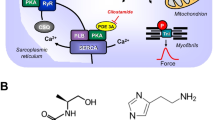Summary
The influence of nondepolarizing muscle relaxants (MR) on the resting and electrically evoked release of tritiated norepinephrine (3H-NE) was investigated, in the absence and presence of 10−4 mol/l cocaine, in the in vitro right atrium preparation of guinea pigs (g.p.) preloaded with3H-NE. In the absence of MR both resting and stimulated3H and3H-NE release remained relatively constant throughout the experiment and the ratios of the evoked release of3H during consecutive stimulation periods (i.e. S2/S1, S3/S2) were close to unity. None of the MR had any effect on resting3H release. Atropine (3× 10−7 mol/l), gallamine (7×10−5 mol/l), and pancuronium (2×10−6 mol/l), but not d-tubocurarine (5×10−6 mol/l) significantly increased stimulated release of3H-NE. The effect of MR on resting or evoked release of3H-NE was not influenced by 10−4 mol/l cocaine. In the presence of atropine gallamine and pancuronium did not affect the release of3H-NE. This finding indicates that the effect of MR was mediated via presynaptic muscarinic receptors. Muscle relaxants and atropine inhibited these receptors and removed the tonic inhibitory effect of acetylcholine (ACh) released from the parasympathetic nerve endings on the release of NE from the sympathetic nerve. This was substantiated by the finding that in the present of cholinesterase inhibition, when the effect of endogenous ACh was amplified and thereby the cholinergic tone was dominant, the total release of3H-NE evoked by stimulation was much lower and muscle relaxants and atropine were much more effective to enhance3H-NE release. Gallamine and pancuronium also increased the force of contraction of the electrically stimulated atria. These findings indicate that the acceleration of the heart rate observed with gallamine and pancuronium in anesthetized man is due to increased release from, and not the inhibition of reuptake of NE by the sympathetic nerve endings of the right atrium.
Similar content being viewed by others
References
Bonta IL, Goorissen EM, Derks FH (1968) Pharmacological interaction between pancuronium bromide and anesthetics. Eur J Pharm 4: 83–90
Bovet D, Bovet-Nitti F, Guarino S, Longo VG, Marotta M (1949) Proprieta farmachodinamiche dia alcuni derivati della succinilcolina dotati di azione curarica. Rendiconti Istituto Superiore di Sanita (Roma) 12: 106–137
Bowman WC (1980) Pharmacology of neuromuscular function. J Wright, Bristol, pp 103–105
Bowman WC (1982) Non-relaxant properties of neuromuscular blocking drugs. Br J Anaesth 54: 147–158
Bowman WC, Webb SN (1972) Neuromuscular blocking and ganglion activities of some acetylcholine antagonists in the cat. J Pharm Pharmacol 24: 762–772
Domeneck JS, Garcia RC, Sain JMR (1976) Pancuronium bromide: an direct sympathetic agent. Br J Anaesth 48: 1143–1148
Foldes FF (1981) The significance of physiological Ca2+ and Mg2+ for in vitro experiments on synaptic transmission. Life Sci 28: 1585–1590
Foldes FF, Klonymus DH, Maisel W, Sciammas F, Pan T (1971) Studies of pancuronium conscious and anesthetized man. Anesthesiology 35: 496–503
Foldes FF, Machaj TS, Carberry PC (1954) The use of gallamine triethiodide (flaxedil) with pentothal sodium nitrous oxide-oxygen anesthesia in abdominal sugery. Anesth Analg 33: 122–128
Foldes FF, Nagashima H, Boros M, Tassonyi E, Fitzal S, Agoston S (1983) Muscular relaxation with atracurium, vecuronium, and duador under balanced anaesthesia. Br J Anaesth 55: 97S-103S
Ivanovich AD, Miletich DJ, Albrecht RF, Zahed B (1975) The effect of pancuronium on myocardial contraction and catecholamine metabolism. J Pharm Pharmacol 27: 837–841
Iversen LL (1967) The uptake and storeage of noradrenaline in sympathetic nerves. Cambridge University Press, Cambridge, pp 151–154
Jarrold Z (ed) (1974) Biostatistical analysis. Prentice-Hall, Englewood Cliffs, NJ
McCulloch MW, Rand MJ, Story DF (1974) Resting and stimulation-induced efflux of tritium from guinea-pig atria incubated with3H-noradrenaline. Clin Exp Pharmacol Physiol 1: 275–289
Morris RB, Cahalan MK, Miller D, Wilkinson PL, Quasha AL, Robinson SL (1983) The cardiovascular effects of vecuronium (ORG-NC 45) and pancuronium in patients under—going coronary artery bypass grafting. Anesthesiology 5: 438–440
Muscholl E (1961) Effects of cocaine and related drugs on the uptake of noradrenaline by heart and spleen. Br J Pharmacol 16: 352–359
Muscholl E (1985) Peripheral muscarinic control of norepinephrine release in the cardiovascular system. Am J Physiol 239: H 713-H720
Riker WF, Wescoe WC (1951) The pharmacology of flaxedil with observations on certain analogs. Ann Acad Sci 54: 373–392
Salt PJ, Barnes PK, Conway CM (1980) Inhibition of neuronal uptake of noradrenaline in the isolated perfused rat heart by pancuronium and its homologues, Org 6368, Org 7268, and NC45. Br J Anaesth 52: 313–317
Saxena PR, Bonta TL (1970) Mechanism of selective cardiac vagolytic action of pancuronium bromide. Eur J Pharmacol 1: 332–336
Son LS, Waud BE (1980) Effects of non depolarizing blocking agents on the cardiac vagus nerve in the guinea-pig. Br J Anaesth 52: 981–986
Vizi ES (1979) Presynaptic modulation of neurochemical transmission. Prog Neurobiol 12: 181–290
Vizi ES (1984) Non-synaptic interaction between neurons. Wiley, Chichester
Vizi ES, Ono K, Adam-Vizi V, Foldes FF (1984) Presynaptic inhibitory effect of Metnkephaline on 14C-acetylcholine release from the myenteric plexus and its interaction with muscarinic negative feedback inhibition. J Pharmacol Exp Ther 230: 493–499
Vizi ES, Somogyi GT, Harsing LG Jr, Zimanyi I (1985) External Ca-independent release of norepinephrine by sympathomimetics and its role in negative feedback modulation. Proc Natl Acad Sci U.S.A. 82: 8775–8779
Author information
Authors and Affiliations
Rights and permissions
About this article
Cite this article
Földes, F.F., Kobayashi, O., Kinjo, M. et al. Presynaptic effect of muscle relaxants on the release of3H-norepinephrine controlled by endogenous acetylcholine in guinea pig atrium. J. Neural Transmission 76, 169–180 (1989). https://doi.org/10.1007/BF01260502
Received:
Accepted:
Issue Date:
DOI: https://doi.org/10.1007/BF01260502




